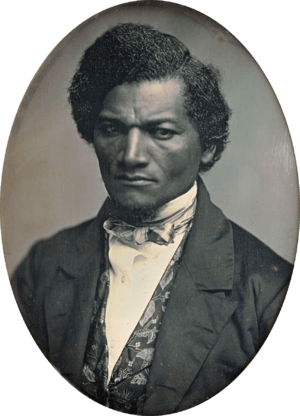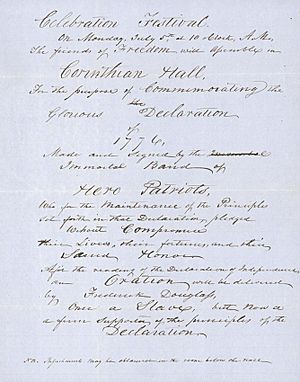Fifth of July (New York) facts for kids
The Fifth of July is a historic celebration in New York. It marks the day slavery officially ended in the state in 1827. A law passed earlier had set July 4th as the day slavery would end. However, African Americans chose to celebrate on July 5th. They did this to avoid possible violence from white people celebrating Independence Day.
These celebrations continued on July 5th for many years in New York. After 1834, they became less common. This was partly due to anti-abolitionist riots and the end of slavery in the British Empire. The tradition mostly blended into celebrations for August 1st, which marked British abolition. In 2020, New York officially recognized the holiday. It is now called Abolition Commemoration Day and is observed on the second Monday in July.
Contents
History of the Fifth of July
Planning the First Celebration
African Americans in New York began planning for this special day as early as March 1827. Their plans were even reported in a newspaper called Freedom's Journal. In Albany, Nathaniel Paul led a meeting where they decided to celebrate on July 5th. They felt that since July 4th was for white citizens to celebrate national independence, July 5th would be their own day.
The First Celebrations in 1827
On July 4, 1827, Black churches in New York held services. They offered prayers and thanks. William Hamilton gave an important speech at the Mother African Methodist Episcopal Zion Church. This church was the site of the biggest celebration. He spoke about the difficult past and how the new law was a great step forward. He declared that "no more shall negro and slave be synonymous." People left these events quietly. They were careful because they feared white people celebrating July 4th might start fights.
The largest celebration in New York City on July 5, 1827, saw 2,000 to 4,000 people gather. They met at St. John's Park. Samuel Hardenburgh led the parade. Many groups took part, including the New York African Society for Mutual Relief. From the park, they marched to Zion Church. Then they went to City Hall on Broadway. There, they met Mayor William Paulding Jr.. Nathaniel Paul also spoke in Albany on the same day. There was some discussion within the community about how public these celebrations should be. Henry Highland Garnet and James McCune Smith remembered being part of the first celebration in New York City. They recalled people from different parts of the African diaspora, including the Caribbean and Africa.
Changes Over Time
The seventh yearly celebration was written about in 1833. An Englishman, believed to be James Boardman, described it in his travel writings.
In June 1834, the National Convention of Free People of Colour met. They decided against having July 5th parades. They preferred private community events on July 4th for safety reasons. The next month, celebrations on July 7th were attacked. This incident started the New York anti-abolitionist riots.
Legacy of the Fifth of July
The Black community in New York continued to use July 4th for serious thought. They reflected on the difference between America's promises and its reality. They kept July 5th for their own personal celebration. After 1834, these celebrations became less frequent. The tradition remained important but often merged with August 1st celebrations. This date marked Emancipation Day in the British Empire. New York first observed August 1st in 1838.
Frederick Douglass often took part in August 1st celebrations. He gave a famous speech on July 5, 1852, in Rochester. It was titled "What to the Slave Is the Fourth of July?" This speech is seen by many as showing a unique "Fifth of July" idea of patriotism. The speech did not directly mention the custom of July 5th observances. Later mentions of the tradition include an event in Auburn in 1856. William Cooper Nell also noted the tradition in 1859, saying it was declining but still existed.
The New York branches of the Association for the Study of African American Life and History supported making "Abolition Commemoration Day" a state holiday. It was recognized by the state legislature, along with Juneteenth, in 2020.



